Guitar tunings
Guitar tunings assign pitches to the open strings of guitars, including acoustic guitars, electric guitars, and classical guitars. Tunings are described by the particular pitches denoted by notes in Western music. By convention, the notes are ordered from lowest-pitched string (i.e., the deepest bass note) to highest-pitched (thickest string to thinnest).[1]

Standard tuning defines the string pitches as E, A, D, G, B, and E, from lowest (low E2) to highest (high E4). Standard tuning is used by most guitarists, and frequently used tunings can be understood as variations on standard tuning. One mnemonic for this standard guitar tuning is Eddy Ate Dynamite, Good Bye Eddy.
The term guitar tunings may refer to pitch sets other than standard tuning, also called nonstandard, alternative, or alternate. Some tunings are used for particular songs, and might be referred to by the song's title. There are hundreds of such tunings, often minor variants of established tunings. Communities of guitarists who share a musical tradition often use the same or similar tunings.
Standard and alternatives

Standard
Standard tuning is the tuning most frequently used on a six-string guitar and musicians assume this tuning by default if a specific alternate (or scordatura) is not mentioned. In scientific pitch notation,[2] the guitar's standard tuning consists of the following notes:
- E2–A2–D3–G3–B3–E4.
| String | Frequency | Scientific pitch notation |
|---|---|---|
| 1 (E) | 329.63 Hz | E4 |
| 2 (B) | 246.94 Hz | B3 |
| 3 (G) | 196.00 Hz | G3 |
| 4 (D) | 146.83 Hz | D3 |
| 5 (A) | 110.00 Hz | A2 |
| 6 (E) | 82.41 Hz | E2 |
The guitar is a transposing instrument—music for it is notated one octave higher than actual pitch, to reduce the need for ledger lines in music written for the instrument, and simplify reading.[3]
Standard tuning provides reasonably simple fingering (left-hand movement) for playing standard scales and basic chords in all major and minor keys. Separation of the first (high E) and second (B) string, as well as the separation between the third (G), fourth (D), fifth (A), and sixth (low E) strings by a five-semitone interval (a perfect fourth) lets the guitarist play a chromatic scale with each of the four fingers of the left hand controlling one of the first four frets (index finger on fret 1, little finger on fret 4, etc.) only when the hand is in the first position.
The open notes of the second (B) and third (G) strings are separated by a four-semitone interval (a major third). This tuning pattern of (low) fourths, one major-third,[lower-alpha 1] and one fourth was inherited by the guitar from its predecessor instrument, the viol. On the other hand, the irregular major third breaks the fingering patterns of scales and chords, so that guitarists have to memorize multiple chord-shapes for each chord. Scales and chords are simplified by major thirds tuning and all-fourths tuning, which are regular tunings maintaining the same musical interval between consecutive open-string notes.
Chromatic note progression 0 I II III IV open 1st fret (index) 2nd fret (middle) 3rd fret (ring) 4th fret (little) 6th string E2 F2 F♯2/G♭2 G2 G♯2/A♭2 5th string A2 A♯2/B♭2 B2 C3 C♯3/D♭3 4th string D3 D♯3/E♭3 E3 F3 F♯3/G♭3 3rd string G3 G♯3/A♭3 A3 A♯3/B♭3 B3 2nd string B3 C4 C♯4/D♭4 D4 D♯4/E♭4 1st string E4 F4 F♯4/G♭4 G4 G♯4/A♭4
Alternative
Alternative ("alternate") tuning refers to any open-string note arrangement other than standard tuning. These offer different sonorities, chord voicings, and fingerings. Alternative tunings are common in folk music, where the guitar may emulate various modal ethnic instruments and tunings, and may be called upon to produce drone notes. Alternative tunings necessarily change the fingering shapes of common chords, which eases the playing of some chords while increasing the difficulty of others.
Some tunings are used for particular songs, and may be named after the song's title. There are hundreds of such tunings, though many are slight variants of other alternate tunings.[4] A few alternative tunings are used regularly by communities of guitarists who share a musical tradition, such as American folk or Celtic folk music.
The hundreds of alternative tunings have been classified into a few categories:[5]
- dropped[6][7]
- open[8]
- both major and minor (cross note)[9][7][10]
- modal[7][11]
- instrumental (based on other stringed instruments)
- miscellaneous (“special”).[7][10][12]
Joni Mitchell developed a shorthand descriptive method of noting guitar tuning wherein the first letter documents the note of the lowest string, and is followed by the relative fret (half-step) offsets required to obtain the pitch of the next (higher) string.[13] This scheme highlights pitch relationships and simplifies the process of comparing different tuning schemes.
String gauges
Some alternative tunings are difficult or even impossible to achieve with conventional sets of guitar strings, which have gauges optimized for standard tuning. With conventional sets, some higher tunings increase string-tension until playing requires significantly more finger-strength and stamina, or even until a string snaps or the guitar is warped; with lower tunings, strings may be loose and buzz. Tone is also negatively affected by unsuitable string gauge.
Generally, alternative tunings benefit from re-stringing of the guitar with string gauges chosen to optimize particular tunings [14] by using lighter strings for higher notes (to lower tension) and heavier strings for lower notes (to prevent string buzz);
Dropped tunings
A dropped tuning starts with standard tuning and typically lowers the pitch of ("drops") only a single string, almost always the lowest-pitched (E) string on the guitar, though occasionally the A string is lowered.
The drop D tuning is common in classical guitar and heavy metal music.[15][16] The low E string is tuned down one whole step (to D) and the rest of the strings remain in standard tuning. This creates an "open power chord" (three-note fifth) with the low three strings (DAD).
With increased popularity of lower-tuned guitars, and subsequent "down tuning" of standard EADGBE tuning, reference is sometimes made to the analogous dropping of the lowest string by a full tone (e.g. "drop A").
Open tunings

An open tuning lets the guitarist play a chord by strumming the open strings (no strings fretted).
Open tunings may be chordal or modal. In chordal open tunings, the base chord consists of at least three different pitch classes, and may include all the strings or a subset. The tuning is named for the base chord when played open, typically a major chord, and all similar chords in the chromatic scale are played by barring all strings across a single fret.[17] Open tunings are common in blues and folk music.[18] These tunings are frequently used in the playing of slide and lap-slide ("Hawaiian") guitars, and Hawaiian slack key music.[17][19] Ry Cooder uses open tunings when he plays slide guitar.[18]
Most modern music uses equal temperament because it facilitates playing in any key—as compared to just intonation, which favors a few certain keys, and other keys sound less in tune.[20] Open tunings can provide “better” intonation for certain chords than non-open tunings, because the open strings can be in just intonation.
Sonny Landreth, Keith Richards and other open-G masters often lower the second string slightly so the major third is in tune with the overtone series.[21]
Repetitive open-tunings are used for two classical non-Spanish guitars. For the English guitar, the open chord is C major (C–E–G–C–E–G);[22] for the Russian guitar, which has seven strings, G major (G–B–D–G–B–D–G).[23][24]
When the open strings constitute a minor chord, the open tuning may sometimes be called a cross-note tuning.
Major key tunings
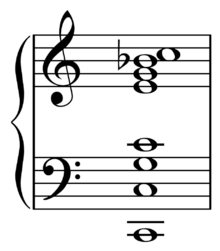
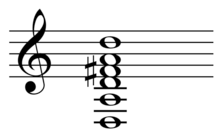
Major open-tunings give a major chord with the open strings.
Open tunings Major triad Repetitive Overtones Other
(often most popular)
Open A (A,C♯,E) A–C♯–E–A–C♯–E A–A–E–A–C♯–E E–A–C♯–E–A–E Open B (B,D♯,F♯) B–D♯–F♯–B–D♯–F♯ B–B–F♯–B–D♯–F♯ B–F♯–B–F♯–B–D♯ Open C (C,E,G) C–E–G–C–E–G C–C–G–C–E–G C–G–C–G–C–E Open D (D,F♯,A) D–F♯–A–D–F♯–A D–D–A–D–F♯–A D–A–D–F♯–A–D Open E (E,G♯,B) E–G♯–B–E–G♯–B E–E–B–E–G♯–B E–B–E–G♯–B–E Open F (F,A,C) F–A–C–F–A–C F–F–C–F–A–C C–F–C–F–A–F Open G (G,B,D) G–B–D–G–B–D G–G–D–G–B–D D–G–D–G–B-D
Open tunings often tune the lowest open note to C, D, or E and they often tune the highest open note to D or E; tuning down the open string from E to D or C avoids the risk of breaking strings, which is associated with tuning up strings.
Open D
The open D tuning (D–A–D–F♯–A–D), also called “Vestopol” tuning,[25] is one of the most common open tunings used by European and American guitarists working with alternative tunings. The Allman Brothers instrumental “Little Martha” used an open-D tuning raised one half step, giving an open E♭ tuning with the same intervalic relationships as open D.[26]
Open C
The English guitar used a repetitive open-C tuning (with distinct open notes C–E–G–C–E–G) that approximated a major-thirds tuning.[22] The C-G-C-G-C-E tuning was used by William Ackerman for his “Townsend Shuffle” and by John Fahey for his tribute to Mississippi John Hurt.[27][28]
The C–C–G–C–E–G tuning uses some of the harmonic sequence (overtones) of the note C.[29][30] This overtone-series tuning was modified by Mick Ralphs, who used a high C rather than the high G for “Can’t Get Enough” on Bad Company. Ralphs said, “It needs the open C to have that ring,” and “it never really sounds right in standard tuning”.[31]
Open G
Mick Ralphs’ open-C tuning was originally an open-G tuning, which listed the initial six overtones of the G note, namely G–G–D–G–B–D; Ralphs used this open-G tuning for “Hey Hey” and while writing the demo of “Can’t Get Enough”.[31]
The open G tuning G–G–D–G–B–D was used by Joni Mitchell for “Electricity”, “For the Roses” and “Hunter (The Good Samaritan)”.[32] Truncating this tuning to G–D–G–B–D for his five-string guitar, Keith Richards plays this overtones-tuning on The Rolling Stones’s “Honky Tonk Women”, “Brown Sugar” and “Start Me Up”.[33]
The seven-string Russian guitar uses the open-G tuning D–G–B–D–G–B–D, which contains mostly major and minor thirds.[34][24]
Creating any kind of open tuning
Any kind of chordal tuning can be achieved, simply by using the notes in the chord and tuning the strings to those notes. For example, Asus4 has the notes A, D, E. By tuning the strings to only those notes, it creates a chordal Asus4 tuning. Since power chords only use two notes, fifth chord tuning use repeats of those two notes.[35]
Power chord (fifths) open tunings:[36] A5 E–A–E–A–A–E B5 F♯–B–F♯–B–B–F♯ C5 C–G–C–G–G–G D5 D–A–D–A–D–D E5 E–B–E–E–B–E F5 F–C–C–C–C–F G5 D–G–D–G–D–G
(These are open chordal tunings for guitar, but bass players can also use them by omitting the last two strings.)
Minor or “cross-note” tunings
Cross-note tunings include a minor third, so giving a minor chord with open strings. Fretting the minor-third string at the first fret produces a major-third, so allowing a one-finger fretting of a major chord.[37] By contrast, it is more difficult to fret a minor chord using an open major-chord tuning.
Cross-note E-minor was used by Bukka White and Skip James.[38]
Other open chordal tunings
Some guitarists choose open tunings that use more complex chords, which gives them more available intervals on the open strings. C6, E6, E7, E6/9 and other such tunings are common among lap-steel players such as Hawaiian slack-key guitarists and country guitarists, and are also sometimes applied to the regular guitar by bottleneck players striving to emulate these styles. A common C6 tuning, for example, is C–E–G–A–C–E, which provides open major and minor thirds, open major and minor sixths, fifths, and octaves. By contrast, most open major or open minor tunings provide only octaves, fifths, and either a major third/sixth or a minor third/sixth—but not both. Don Helms of Hank Williams band favored C6 tuning; slack-key artist Henry Kaleialoha Allen uses a modified C6/7 (C6 tuning with a B♭ on the bottom); Harmon Davis favored E7 tuning; David Gilmour has used an open G6 tuning.
Modal tunings
Modal tunings are open tunings in which the open strings of the guitar do not produce a tertian (i.e., major or minor, or variants thereof) chord. The strings may be tuned to exclusively present a single interval (all fourths; all fifths; etc.) Or they may be tuned to a non-tertian chord (unresolved suspensions such as E–A–B–E–A–E, for example). Modal open tunings may use only one or two pitch classes across all strings (as, for example, some metal guitarists who tune each string to either E or B, forming “power chords” of ambiguous major/minor tonality).
Popular modal tunings include D Modal (D-G-D-G-B-E) and C Modal (C-G-D-G-B-D).
Lowered (standard)
Derived from standard EADGBE, all the strings are tuned lower by the same interval, thus providing the same chord positions transposed to a lower key. Lower tunings are popular among rock and heavy metal bands. The reason for tuning down below standard pitch is usually either to accommodate a singer's vocal range or to get a deeper/heavier sound.[39] Common examples include:
E♭ tuning
Rock guitarists (such as Jimi Hendrix on the songs Voodoo Child (Slight Return) and Little Wing) occasionally tune all their strings down by one semitone to obtain E♭ tuning. This makes the strings easier to bend and with standard fingering results in a lower key.[40]
D tuning
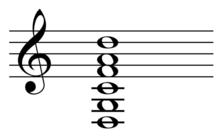
D Tuning, also called One Step Lower, Whole Step Down, Full Step or D Standard, is an alternate tuning for guitar. Each string is lowered by a whole tone or two semitones resulting in D-G-C-F-A-D. It is used mostly by heavy metal bands to achieve a heavier, deeper sound, by blues guitarists, who use it to accommodate string bending and by 12-string guitar players to reduce the mechanical load on their instrument. It was also used for several songs on The Velvet Underground's album The Velvet Underground & Nico.
Regular tunings
| Regular tunings | |
|---|---|
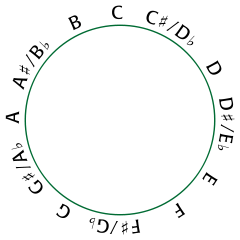 For regular guitar-tunings, the distance between consecutive open-strings is a constant musical-interval, measured by semitones on the chromatic circle. The chromatic circle lists the twelve notes of the octave. | |
| Basic information | |
| Aliases | Uniform tunings |
| Advanced information | |
| Advantages | Simplifies learning by beginners and improvisation by advanced guitarists |
| Disadvantages | Replicating the open chords (“cowboy chords”) of standard tuning is difficult; intermediate guitarists must relearn the fretboard and chords. |
| Regular tunings (semitones) | |
| Trivial (0) | |
| Minor thirds (3) | |
| Major thirds (4) | |
| All fourths (5) | |
| Augmented fourths (6) | |
| New standard (7, 3) | |
| All fifths (7) | |
| Minor sixths (8) | |
| Guitar tunings | |
In standard tuning, there is an interval of a major third between the second and third strings, and all the other intervals are fourths. The irregularity has a price. Chords cannot be shifted around the fretboard in the standard tuning E–A–D–G–B–E, which requires four chord-shapes for the major chords. There are separate chord-forms for chords having their root note on the third, fourth, fifth, and sixth strings.[41]
In contrast, regular tunings have equal intervals between the strings,[42] and so they have symmetrical scales all along the fretboard. This makes it simpler to translate chords. For the regular tunings, chords may be moved diagonally around the fretboard. The diagonal movement of chords is especially simple for the regular tunings that are repetitive, in which case chords can be moved vertically: Chords can be moved three strings up (or down) in major-thirds tuning and chords can be moved two strings up (or down) in augmented-fourths tuning. Regular tunings thus appeal to new guitarists and also to jazz-guitarists, whose improvisation is simplified by regular intervals.
On the other hand, five- and six-string open chords (“cowboy chords”) are more difficult to play in a regular tuning than in standard tuning. Instructional literature uses standard tuning.[43] Traditionally a course begins with the hand in first position,[44] that is, with the left-hand covering frets 1–4.[45] Beginning players first learn open chords belonging to the major keys C, G, and D. Guitarists who play mainly open chords in these three major-keys and their relative minor-keys (Am, Em, Bm) may prefer standard tuning over many regular tunings,[46][47] On the other hand, minor-thirds tuning features many barre chords with repeated notes,[48] properties that appeal to acoustic-guitarists and beginners.
Major thirds and perfect fourths
Standard tuning mixes a major third (M3) with its perfect fourths. Regular tunings that are based on either major thirds or perfect fourths are used, for example, in jazz.
All fourths tuning E2–A2–D3–G3–C4–F4 keeps the lowest four strings of standard tuning, changing the major third to a perfect fourth.[49][50] Jazz musician Stanley Jordan stated that all-fourths tuning “simplifies the fingerboard, making it logical”.[51]
Major-thirds tuning (M3 tuning) is a regular tuning in which the musical intervals between successive strings are each major thirds, for example E2–G♯2–C3–E3–G♯3–C4.[52][53][54][55] Unlike all-fourths and all-fifths tuning, M3 tuning repeats its octave after three strings, which simplifies the learning of chords and improvisation.[43] This repetition provides the guitarist with many possibilities for fingering chords.[52][55] With six strings, major-thirds tuning has a smaller range than standard tuning; with seven strings, the major-thirds tuning covers the range of standard tuning on six strings.[53][54][55]
Major-thirds tunings require less hand-stretching than other tunings, because each M3 tuning packs the octave's twelve notes into four consecutive frets.[53][56] The major-third intervals let the guitarist play major chords and minor chords with two–three consecutive fingers on two consecutive frets.[57]
Chord inversion is especially simple in major-thirds tuning. The guitarist can invert chords by raising one or two notes on three strings—playing the raised notes with the same finger as the original notes. In contrast, inverting triads in standard and all-fourths tuning requires three fingers on a span of four frets.[58] In standard tuning, the shape of an inversion depends on involvement of the major-third between the 2nd and 3rd strings.[59]
All fifths and “new standard tuning”
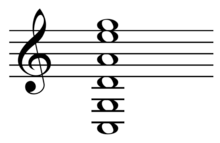
- C2–G2–D3–A3–E4–B4
All-fifths tuning is a tuning in intervals of perfect fifths like that of a mandolin or a violin; other names include “perfect fifths” and “fifths”.[60] It has a wide range. Its implementation has been impossible with nylon strings and has been difficult with conventional steel strings. The high B makes the first string very taut, and consequently a conventionally gauged string easily breaks.
Jazz guitarist Carl Kress used a variation of all-fifths tuning—with the bottom four strings in fifths, and the top two strings in thirds, resulting in B♭1–F2–C3–G3–B3–D4. This facilitated tenor banjo chord shapes on the bottom four strings and plectrum banjo chord shapes on the top four strings. Contemporary New York jazz-guitarist Marty Grosz uses this tuning.
All-fifths tuning has been approximated by the so-called “New Standard Tuning” (NST) of King Crimson’s Robert Fripp, which NST replaces all-fifths' high B4 with a high G4. To build chords, Fripp uses “perfect intervals in fourths, fifths and octaves”, so avoiding minor thirds and especially major thirds,[61] which are sharp in equal temperament tuning (in comparison to thirds in just intonation). It is a challenge to adapt conventional guitar-chords to new standard tuning, which is based on all-fifths tuning.[lower-alpha 2] Some closely voiced jazz chords become impractical in NST and all-fifths tuning.[63]
Instrumental tunings
These are tunings in which some or all strings are retuned to emulate the standard tuning of some other instrument, such as a lute, banjo, cittern, mandolin, etc. Many of these tunings overlap other categories, especially open and modal tunings.
Miscellaneous or “special” tunings
This category includes everything that does not fit into any of the other categories, for example (but not limited to): tunings designated only for a particular piece; non-western intervals and modes; micro- or macro-tones; and “hybrid tunings” combining features of major alternate tuning categories – most commonly an open tuning with the lowest string dropped.[64]
See also
- Bass guitar tuning
- List of guitar tunings
- Mathematics and music
- Open G tuning
- Stringed instrument tunings
Notes
- Sometimes referred to as warp refraction.
- Musicologist Eric Tamm wrote that despite “considerable effort and search I just could not find a good set of chords whose sound I liked” for rhythm guitar.[62]
Citation references
- Denyer (1992, pp. 68–69)
- "Online guitar tuner". TheGuitarLesson.com. Archived from the original on 2013-08-24. Retrieved August 27, 2013.
- "Transposing Instruments – Music Theory Academy". Retrieved 2019-09-24.
- Weissman (2006, ‘Off-the-wall tunings: A brief inventory’ (Appendix A), pp. 95–96)
- Roche (2004, ‘Categories of tunings’, p. 153)
- Roche (2004, pp. 153–156)
- Denyer (1992, pp. 158–159)
- Roche (2004, ‘Open tunings’, pp. 156–159)
- Roche (2004, ‘Cross-note tunings’, p. 166)
- Sethares (2011)
- Roche (2004, ‘Modal tunings’, pp. 160–165)
- Roche (2004, ‘More radical tunings’, p. 166)
- "Notation". Joni Mitchell. Archived from the original on 2016-03-15. Retrieved 2016-03-20.
- Roche (2004, ‘String gauges and altered tunings’, p. 169–170)
- Powis, Simon (April 8, 2018). "Drop D Tuning Tips". Classical Guitar Corner. Retrieved 2019-03-28.
- Bowcott, Nick (September 10, 2008). "The Doom Generation: The Art of Playing Heavy". Guitar World. Retrieved 2019-03-28.
- Sethares (2009, p. 16)
- Denyer (1992, p. 158)
- Denyer (1992, p. 160)
- Gold, Jude (December 2005). "Just desserts: Steve Kimock shares the sweet sounds of justly tuned thirds and sevenths". Master class. Guitar Player. – via Questia (subscription required)
- Gold, Jude (June 2007). "Fender VG Stratocaster". Gear: Bench Test (Product/service evaluation). Guitar Player. Archived from the original on 2013-01-16.
- Annala & Mätlik (2007, p. 30)
- Ophee, Matanya (ed.). 19th Century etudes for the Russian 7-string guitar in G Op. The Russian Collection. 9. Editions Orphee. PR.494028230. Archived from the original on 2013-07-04.
– Ophee, Matanya (ed.). Selected Concert Works for the Russian 7-String Guitar in G open tuning. The Russian Collection. 10. Editions Orphee. PR.494028240. Archived from the original on 2013-07-04. - Timofeyev, Oleg V. (1999). The golden age of the Russian guitar: Repertoire, performance practice, and social function of the Russian seven-string guitar music, 1800–1850. Duke University, Department of Music. pp. 1–584. University Microfilms (UMI), Ann Arbor, Michigan, number 9928880.
- Grossman (1972, p. 29)
- Sethares (2009, pp. 20–21)
- Sethares (2009, pp. 18–19)
- Baughman, Steve (2004). "Open C". Mel Bay Beginning Open Tunings. Pacific, Missouri: Mel Bay Publications. pp. 8–14. ISBN 978-0-7866-7093-2.
- Guitar Tunings Database (2013). "CCGCEG Guitar Tuner". CCGCEG: Open C via harmonic overtones. Archived from the original on 10 March 2013. Retrieved 20 February 2013.
- Persichetti (1961, pp. 23–24)
- Sharken, Lisa (15 May 2001). "Mick Ralphs: The rock 'N' roll fantasy continues". Vintage Guitar. Archived from the original on 8 February 2013. Retrieved 21 February 2013.
- "List of all Guitar and Piano Transcriptions". GGDGBD. JoniMitchell.com. Archived from the original on May 18, 2015. Retrieved February 22, 2013.
- Ellis, Andy (2005). "How to play like ... Keith Richards". Guitar Player. Retrieved 24 March 2013. – via Questia (subscription required)
- Bellow (1970, p. 164)
- "Asus4 Piano Chord - Piano Chord Chart - 8notes.com". 8notes.com. Archived from the original on 6 September 2017. Retrieved 6 May 2018.
- "Piano Chord Chart". 8notes.com. Archived from the original on 14 June 2017. Retrieved 6 May 2018.
- Sethares (2001, p. 16)
- Cohen, Andy (22 March 2005). "Stefan Grossman- Country Blues Guitar in Open Tunings". Sing Out!. 49 (1): 152.
- http://www.betterguitar.com/instruction/rhythm_guitar/tune_down_half_step/tune_down_half_step.html
- Serna, Desi (2015). Guitar Rhythm and Technique For Dummies. For Dummies. p. 80. ISBN 978-1119022879. Retrieved 25 January 2019.
it's fairly common in rock music for guitarists to tune all of their strings down by a half-step
- Denyer (1992, p. 119)
- Sethares (2001, p. 52)
- Kirkeby, Ole (1 March 2012). "Major thirds tuning". m3guitar.com. cited by Sethares (2011). Archived from the original on 11 April 2015. Retrieved 10 June 2012.
- White, Mark (Fall 2005). "Reading skills: The guitarist's nemesis?". Berklee Today. Vol. 17 no. 2. Boston, MA: Berklee College of Music. ISSN 1052-3839.
- Denyer (1992, p. 72)
- Peterson (2002, p. 37)
- Griewank (2010, p. 5)
- Sethares (2001, pp. 54–55)
- Sethares (2001, pp. 58–59)
- Bianco, Bob (1987). Guitar in Fourths. New York City: Calliope Music. ISBN 0-9605912-2-2. OCLC 16526869.
- Ferguson (1986, p. 76)
- Sethares (2001, pp. 56)
- Peterson (2002, pp. 36–37)
- Griewank (2010)
- Patt, Ralph (14 April 2008). "The major 3rd tuning". Ralph Patt's jazz web page. ralphpatt.com. cited by Sethares (2011). Retrieved 10 June 2012.
- Griewank (2010, p. 9)
- Griewank (2010, p. 2)
- Griewank (2010, p. 10)
- Denyer (1992, p. 121)
- Sethares (2001, ‘The mandoguitar tuning’ 62–63)
- Mulhern, Tom (January 1986). "On the discipline of craft and art: An interview with Robert Fripp". Guitar Player. 20: 88–103. Archived from the original on 16 February 2015. Retrieved 8 January 2013.
- Tamm (2003)
- Sethares (2001, ‘The mandoguitar tuning’, pp. 62–63)
- Whitehill, Dave; Alternate Tunings for Guitar; p. 5 ISBN 0793582199
References
- Allen, Warren (22 September 2011) [30 December 1997]. "WA's encyclopedia of guitar tunings". (Recommended by Marcus, Gary (2012). Guitar zero: The science of learning to be musical. Oneworld. p. 234. ISBN 9781851689323.). Archived from the original on 13 July 2012. Retrieved 27 June 2012.
- Annala, Hannu; Mätlik, Heiki (2007). "Composers for other plucked instruments: Rudolf Straube (1717–1785)". Handbook of Guitar and Lute Composers. Translated by Katarina Backman. Mel Bay. ISBN 978-0-786-65844-2.
- Bellow, Alexander (1970). The illustrated history of the guitar. Colombo Publications.
- Denyer, Ralph (1992). "Playing the guitar ('How the guitar is tuned', pp. 68–69, and 'Alternative tunings', pp. 158–159)". The guitar handbook. Special contributors Isaac Guillory and Alastair M. Crawford (Fully revised and updated ed.). London and Sydney: Pan Books. pp. 65–160. ISBN 0-330-32750-X.
- Ferguson, Jim (1986). "Stanley Jordan". In Casabona, Helen; Belew, Adrian (eds.). New directions in modern guitar. Guitar Player basic library. Hal Leonard Publishing. pp. 68–76. ISBN 978-0-88188-423-4.
- Griewank, Andreas (1 January 2010), Tuning guitars and reading music in major thirds, Matheon preprints, 695, Berlin, Germany: DFG research center "MATHEON, Mathematics for key technologies" Berlin, urn:nbn:de:0296-matheon-6755. Postscript file and Pdf file, archived from the original on 8 November 2012
- Grossman, Stefan (1972). The book of guitar tunings. New York: Amsco Publishing Company. ISBN 0-8256-2806-7. LCCN 74-170019.
- Persichetti, Vincent (1961). Twentieth-century harmony: Creative aspects and practice. New York: W. W. Norton. ISBN 0-393-09539-8. OCLC 398434.
- Peterson, Jonathon (2002). "Tuning in thirds: A new approach to playing leads to a new kind of guitar". American Lutherie: The Quarterly Journal of the Guild of American Luthiers. Tacoma, WA: The Guild of American Luthiers. 72 (Winter): 36–43. ISSN 1041-7176. Archived from the original on 21 October 2011. Retrieved 9 October 2012.
- Roche, Eric (2004). "5 Thinking outside the box". The acoustic guitar Bible. London: Bobcat Books Limited, SMT. pp. 151–178. ISBN 1-84492-063-1.
- Sethares, Bill (2001). "Regular tunings" (PDF). Alternate tuning guide. Madison, Wisconsin: University of Wisconsin; Department of Electrical Engineering. pp. 52–67. Retrieved 19 May 2012.
- Sethares, Bill (2009) [2001]. Alternate tuning guide (PDF). Madison, Wisconsin: University of Wisconsin; Department of Electrical Engineering. Retrieved 19 May 2012.
- Sethares, William A. (2011). "Alternate tuning guide". Madison, Wisconsin: University of Wisconsin; Department of Electrical Engineering. Retrieved 19 May 2012.
- Tamm, Eric (2003) [1990]. "Chapter Ten: Guitar Craft". Robert Fripp: From crimson king to crafty master. Faber and Faber. ISBN 0-571-16289-4. Archived from the original on 26 October 2011. Retrieved 25 March 2012 – via Progressive Ears. Zipped Microsoft Word Document
- Weissman, Dick (2006). Guitar tunings: A comprehensive guide. Routledge. ISBN 9780415974417. LCCN 0415974410.
Further reading
- Anonymous (2000). Alternate tunings guitar essentials. Acoustic Guitar Magazine's private lessons. String Letter Publishing. Hal Leonard Publishing Corporation. ISBN 978-1-890490-24-9. LCCN 2001547503.
- Hanson, Mark (1995). The complete book of alternate tunings. Accent on Music. ISBN 978-0-936799-13-1.
- Hanson, Mark (1997). Alternate tunings picture chords. Accent on Music. ISBN 978-0-936799-14-8.
- Heines, Danny (2007). Mastering alternate tunings: A revolutionary system of fretboard navigation for fingerstyle guitarists. Hal Leonard. ISBN 978-0-634-06569-9.
- Johnson, Chad (2002). Alternate tuning chord dictionary. Hal Leonard. ISBN 978-0-634-03857-0. LCCN 2005561612.
- Maloof, Richard (2007). Alternate tunings for guitar. Cherry Lane Music Company. ISBN 978-1-57560-578-4. LCCN 2008560110.
- Shark, Mark (2008). The tao of tunings: A map to the world of alternate tunings. Hal Leonard Corporation. ISBN 978-1-4234-3087-2.
External links
- Allen, Warren (22 September 2011) [30 December 1997]. "WA's Encyclopedia of Guitar Tunings". (Recommended by Marcus, Gary (2012). Guitar zero: The science of learning to be musical. Oneworld. p. 234. ISBN 9781851689323.). Retrieved 27 June 2012.
- Sethares, William A. (12 May 2012). "Alternate tuning guide: Interactive". Uses Wolfram Cdf player. Retrieved 27 June 2012.
| The Wikibook Guitar has a page on the topic of: Tuning the Guitar (to standard tuning) |
| The Wikibook Guitar has a page on the topic of: Alternative tunings |

